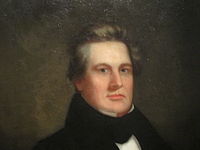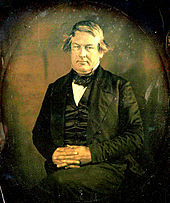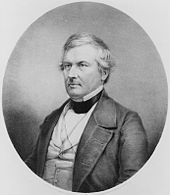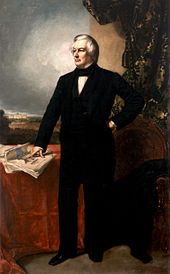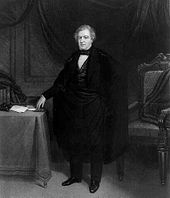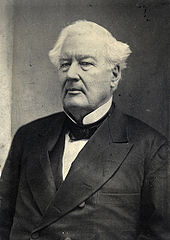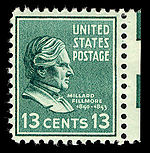- Millard Fillmore
-
Millard Fillmore 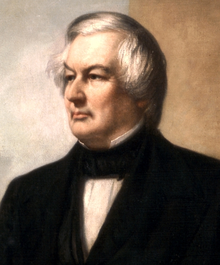
13th President of the United States In office
July 9, 1850 – March 4, 1853Preceded by Zachary Taylor Succeeded by Franklin Pierce 12th Vice President of the United States In office
March 4, 1849 – July 9, 1850President Zachary Taylor Preceded by George Dallas Succeeded by William King 14th Comptroller of New York In office
January 1, 1848 – February 20, 1849Governor John Young
Hamilton FishPreceded by Azariah Flagg Succeeded by Washington Hunt Member of the U.S. House of Representatives
from New York's 32nd districtIn office
March 4, 1837 – March 3, 1843Preceded by Thomas Love Succeeded by William Moseley In office
March 4, 1833 – March 3, 1835Preceded by Constituency established Succeeded by Thomas Love Personal details Born January 7, 1800
Summerhill, New York, U.S.Died March 8, 1874 (aged 74)
Buffalo, New York, U.S.Political party American Party (1856–1860) Other political
affiliationsAnti-Masonic Party (Before 1832)
Whig Party (1832–1856)Spouse(s) Abigail Powers (1826–1853)
Caroline Carmichael (1858–1874)Children Millard
MaryProfession Lawyer Religion Unitarianism Signature 
Military service Service/branch New York Guard Battles/wars Mexican-American War
American Civil WarMillard Fillmore (January 7, 1800 – March 8, 1874) was the 13th President of the United States (1850–1853) and the last member of the Whig Party to hold the office of president. As Zachary Taylor's Vice President, he assumed the presidency after Taylor's death.
Fillmore opposed the proposal to keep slavery out of the territories annexed during the Mexican–American War (to appease the South), and so supported the Compromise of 1850, which he signed, including the Fugitive Slave Act ("Bloodhound Law") which was part of the compromise. On the foreign policy front, he furthered the rising trade with Japan and clashed with the French over Napoleon III's attempt to annex Hawaii, and with the French and the British over the attempt of Narciso López to invade Cuba. After his presidency, he joined the Know-Nothing movement; throughout the Civil War, he opposed President Lincoln and during Reconstruction supported President Johnson.
Fillmore co-founded the University of Buffalo and helped found the Buffalo Historical Society.
Contents
Early life and career
Fillmore was born in a log cabin[1] in Moravia, Cayuga County, in the Finger Lakes region of New York State, on January 7, 1800, to Nathaniel Fillmore and Phoebe Millard, as the second of nine children and the eldest son.[2] He later lived in East Aurora, New York in the southtowns region, south of Buffalo.[3][4] Though Fillmore's ancestors were Scottish Presbyterians on his father's side and English dissenters on his mother's, he became a Unitarian in later life.[5] His father apprenticed him to cloth maker Benjamin Hungerford in Sparta, New York,[6] at age fourteen to learn the cloth-making trade. He left after four months, but subsequently took another apprenticeship in the same trade at New Hope, New York. He struggled to obtain an education living on the frontier and attended New Hope Academy for six months in 1819. Later that year, he began to clerk for Judge Walter Wood of Montville, New York, under whom Fillmore began to study law.
He fell in love with Abigail Powers, whom he met while at New Hope Academy and later married on February 5, 1826.[7] The couple had two children, Millard Powers Fillmore and Mary Abigail Fillmore. After leaving Wood and buying out his apprenticeship, Fillmore moved to Buffalo, where he continued his studies in the law office of Asa Rice and Joseph Clary. He was admitted to the bar in 1823 and began his law practice in East Aurora where, in 1825, he built a house for his new bride. In 1834, he formed a law partnership, Fillmore and Hall (becoming Fillmore, Hall and Haven in 1836), with close friend Nathan K. Hall (who would later serve in his cabinet as Postmaster General).[8] It would become one of western New York's most prestigious firms,[9] and exists to this day as Hodgson Russ LLP. In 1846, he founded the private University of Buffalo, which today is the public University at Buffalo, The State University of New York, the largest school in the New York state university system.
He served in the New York militia during the Mexican–American War.
Politics
 Millard Fillmore helped build this house in East Aurora, New York, and lived here 1826–1830.
Millard Fillmore helped build this house in East Aurora, New York, and lived here 1826–1830.
In 1828, Fillmore was elected to the New York State Assembly on the Anti-Masonic ticket, serving three one-year terms, from 1829 to 1831. In his final term he chaired a special legislative committee to enact a new bankruptcy law that eliminated debtors' prison. As the measure had support among some Democrats, he maneuvered the law into place by taking a nonpartisan approach and allowing the Democrats to take credit for the bill. This kind of inconspicuousness and avoiding the limelight would later characterize Fillmore's approach to politics on the national stage.
He later won election as a Whig (having followed his mentor Thurlow Weed into the party) to the 23rd Congress in 1832, serving from 1833 to 1835. He was reelected in 1836 to the 25th Congress, to the 26th and to the 27th Congresses serving from 1837 to 1843, declining to be a candidate for re-nomination in 1842.
In Congress, he opposed admitting Texas as a slave territory, he advocated internal improvements and a protective tariff, he supported John Quincy Adams by voting to receive anti-slavery petitions, he advocated the prohibition by Congress of the slave trade between the states, and he favored the exclusion of slavery from the District of Columbia.[10][11] He came in second place in the bid for Speaker of the House of Representatives in 1841. He served as chair of the House Ways and Means Committee from 1841 to 1843 and was an author of the Tariff of 1842, as well as two other bills that President John Tyler vetoed.
After leaving Congress, Fillmore was the unsuccessful Whig candidate for Governor of New York in 1844. He was the first New York State Comptroller elected by general ballot, defeating Orville Hungerford 174,756 to 136,027 votes,[12] and was in office from 1848 to 1849. As state comptroller, he revised New York's banking system, making it a model for the future National Banking System.
Vice Presidency 1849–1850
At the Whig national convention in 1848, the nomination of Gen. Zachary Taylor for president angered supporters of Henry Clay and opponents of allowing slavery in the territories gained in the Mexican–American War. A group of practical Whig politicians nominated Fillmore for vice president. Fillmore came from a non-slave state and delegates believed he would help the ticket carry the populous state of New York.
Fillmore was also selected in part to block New York state machine boss Thurlow Weed from receiving the vice presidential nomination (and his front man William H. Seward from receiving a position in Taylor's cabinet). Weed eventually got Seward elected to the Senate. This competition between Seward and Fillmore led to Seward's becoming a more vocal part of cabinet meetings and having more of a voice than Fillmore in advising the administration. The battle would continue even after Taylor's death.
Taylor and Fillmore disagreed on the slavery issue in the new western territories taken from Mexico in the Mexican–American War. Taylor wanted the new states to be free states, while Fillmore supported slavery in those states to appease the South. In his own words: "God knows that I detest slavery, but it is an existing evil ... and we must endure it and give it such protection as is guaranteed by the Constitution."
Fillmore presided over the Senate during the months of nerve-wracking debates over the Compromise of 1850. During one debate, Senator Henry S. Foote of Mississippi pulled a pistol on Senator Thomas Hart Benton of Missouri. Fillmore made no public comment on the merits of the compromise proposals. A few days before President Taylor's death, however, Fillmore suggested to the president that he would vote in favor of the North if the vote on Henry Clay's bill was tied.
Presidency 1850–1853
Domestic Affairs
After Taylor died suddenly on July 9, 1850, Fillmore became president. The change in leadership also signaled an abrupt political shift. Fillmore had very different views on the slavery issue. Before Taylor's death, Fillmore told him that, as President of the Senate, he would give his tie-breaking vote to the Compromise of 1850.[13] When Fillmore took office, the entire cabinet offered their resignations.[13] Fillmore accepted them all and appointed men who, except for Treasury Secretary Thomas Corwin, favored the Compromise of 1850.[13] When the compromise finally came before both Houses of Congress, it was very watered down. As a result, Fillmore urged Congress to pass the original bill. This move only provoked an enormous battle where "forces for and against slavery fought over every word of the bill."[13] To Fillmore's disappointment the bitter battle over the bill crushed public support.[13] Clay, exhausted, left Washington to recuperate, passing leadership to Senator Stephen A. Douglas of Illinois. At this critical juncture, President Fillmore announced his support of the Compromise of 1850.[13]
On August 6, 1850, he sent a message to Congress recommending that Texas be paid to abandon its claims to part of New Mexico. This, combined with his mobilization of 750 Federal troops to New Mexico, helped shift a critical number of northern Whigs in Congress away from their insistence upon the Wilmot Proviso—the stipulation that all land gained by the Mexican War must be closed to slavery.
Douglas's effective strategy in Congress combined with Fillmore's message to Congress gave momentum to the Compromise movement. Breaking up Clay's single legislative package, Douglas presented five separate bills to the Senate:
- Admit California as a free state.
- Settle the Texas boundary and compensate the state for lost lands.
- Grant territorial status to New Mexico.
- Place federal officers at the disposal of slaveholders seeking escapees—the Fugitive Slave Act.
- Abolish the slave trade, but not slavery, in the District of Columbia.
Each measure obtained a majority, and, by September 20, President Fillmore had signed them into law. Webster wrote, "I can now sleep of nights." Whigs on both sides refused to accept the finality of Fillmore's law (which led to more party division, and a loss of numerous elections), which forced Northern Whigs to say "God Save us from Whig Vice Presidents." Fillmore's greatest difficulty with the fugitive slave law was enforcing it without showing favor to Southern Whigs. His solution was to appease both northern and southern Whigs. He called for enforcing the fugitive slave law in the North, and enforcing in the South a law forbidding involvement in Cuba (for the sole purpose of adding it as a slave state).
Fillmore appointed Brigham Young as the first governor of the Utah Territory in 1850.[14] In gratitude for creating the Utah Territory in 1850 and appointing Brigham Young as governor, Young named the territorial capital "Fillmore" and the surrounding county "Millard".[15] Fillmore, a bookworm, started the White House library when he found the White House devoid of books.
Foreign Affairs
In foreign affairs, Fillmore was particularly active in the Asia-Pacific region, especially Japan. American shipping interests had become more keen on opening Japan up to outside trade because it would allow them to stop for supplies en route to China and Southeast Asia.[16] American shippers also looked to the British opening of China to trade as an example of the "benefits of new trade markets."[16] Fillmore, with help from Secretary of State Daniel Webster, sent Commodore Matthew C. Perry to open Japan to Western trade.[16] Though Perry did not reach Japan until Franklin Pierce had replaced Fillmore as president,[16] Fillmore does earn the credit for ending Japanese isolation because it was he who ordered the trade mission. Fillmore was also a staunch defender against foreign intervention in Hawaii. France's Napoleon III attempted to annex the Hawaiian Islands, but was forced to withdraw after a strongly worded message from Fillmore suggesting that "the United States would not stand for any such action."[16]
Though President Taylor had signed the Clayton–Bulwer Treaty preventing Britain and the US from taking more possessions in the Americas, Great Britain and the United States were still attempting to gain ground in the region.[16] The situation became tense enough that Fillmore ordered several warships to guard American merchants in an attempt to prevent British interference.[16] Fillmore was also caught in a situation involving Cuba. Many southerners were eager to expand the bounds of slavery and since slavery territories were locked down because of the Compromise of 1850, many southerners turned to the Caribbean. Venezuelan Narciso López gathered a small force of Americans to invade Cuba. Though Fillmore tried to block such efforts, he was nevertheless unsuccessful as López managed to sail out of New Orleans.[16] Despite the failure of the invasion, López tried another invasion a year later which came to a quick end after Spanish troops routed them from the island. The incident became particularly embarrassing for Fillmore because southerners felt he should have supported the invasion, while Northern democrats were upset at his apology to the Spanish.[16] The French and British dispatched warships to the region in response. Fillmore sent a stern warning saying that under certain conditions control of Cuba "might be almost essential to our [America's] safety."[16]
Another issue that presented itself during Fillmore's presidency was the arrival of Lajos Kossuth, the exiled leader of a failed Hungarian revolution. Kossuth wanted the United States to abandon its nonintervention policies when it came to European affairs and recognize Hungary's independence. The problem came with the enormous support Kossuth received from German-American immigrants to the United States (who were essential in the reelection of both Whigs and Democrats). Fillmore refused to change American policy, and decided to remain neutral despite the political implications that neutrality would produce.
Administration and cabinet
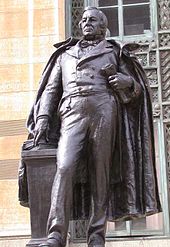 Statue of Fillmore outside City Hall in downtown Buffalo, New York
Statue of Fillmore outside City Hall in downtown Buffalo, New York
The Fillmore Cabinet Office Name Term President Millard Fillmore 1850–1853 Vice President None 1850–1853 Secretary of State Daniel Webster 1850–1852 Edward Everett 1852–1853 Secretary of Treasury Thomas Corwin 1850–1853 Secretary of War Charles M. Conrad 1850–1853 Attorney General John J. Crittenden 1850–1853 Postmaster General Nathan K. Hall 1850–1852 Samuel D. Hubbard 1852–1853 Secretary of the Navy William A. Graham 1850–1852 John P. Kennedy 1852–1853 Secretary of the Interior Thomas M. T. McKennan 1850 Alexander H. H. Stuart 1850–1853 Judicial appointments
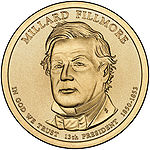 Presidential Dollar of Millard Fillmore
Presidential Dollar of Millard Fillmore
Supreme Court
Fillmore appointed the following Justices to the Supreme Court of the United States:
Judge Seat Began active
serviceEnded active
serviceBenjamin Robbins Curtis Seat 2 September 22, 1851[17] September 30, 1857 Other courts
Fillmore was able to appoint only four other federal judges, all to United States district courts:
Judge Court Began active
serviceEnded active
serviceJohn Glenn D. Md. March 19, 1852 July 8, 1853 Nathan K. Hall N.D.N.Y. August 31, 1852 March 2, 1874 Ogden Hoffman, Jr. N.D. Cal.
S.D. Cal.February 27, 1851 July 23, 1866
January 18, 1854[18]James McHall Jones S.D. Cal. December 26, 1850 December 15, 1851 States admitted to the Union
- California – September 9, 1850
Later life
Fillmore was one of the founders of the University of Buffalo. The school was chartered by an act of the New York State Legislature on May 11, 1846, and at first was only a medical school.[19] Fillmore was the first Chancellor, a position he held while both Vice President and President. After leaving office, Fillmore returned to Buffalo and continued to serve as chancellor of the school.
After the death of his daughter Mary, Fillmore went abroad. While touring Europe in 1855, Fillmore was offered an honorary Doctor of Civil Law (D.C.L.) degree by the University of Oxford. Fillmore turned down the honor, explaining that he had neither the "literary nor scientific attainment" to justify the degree.[20] He is also quoted as having explained that he "lacked the benefit of a classical education" and could not, therefore, understand the Latin text of the diploma, adding that he believed "no man should accept a degree he cannot read."[7]
By 1856, Fillmore's Whig Party had ceased to exist, having fallen apart due to dissension over the slavery issue, and especially the Kansas–Nebraska Act of 1854. Fillmore refused to join the new Republican Party, where many former Whigs, including Abraham Lincoln, had found refuge. Instead, Fillmore joined the anti-immigrant, anti-Catholic American Party, the political organ of the Know-Nothing movement.
He ran in the election of 1856 as the party's presidential candidate, attempting to win a nonconsecutive second term as President (a feat accomplished only once in American politics, by Grover Cleveland). His running mate was Andrew Jackson Donelson, nephew of former president Andrew Jackson. Fillmore and Donelson finished third, carrying only the state of Maryland and its eight electoral votes; but he won 21.6% of the popular vote, one of the best showings ever by a Presidential third-party candidate.
On February 10, 1858, after the death of his first wife, Fillmore married Caroline McIntosh, a wealthy widow. Their combined wealth allowed them to purchase a big house in Buffalo, New York. The house became the center of hospitality for visitors, until the health of Fillmore's wife began to decline in the 1860s.
Fillmore helped found the Buffalo Historical Society (now the Buffalo and Erie County Historical Society) in 1862 and served as its first president.
Throughout the Civil War, Fillmore opposed President Lincoln and during Reconstruction supported President Johnson. He commanded the Union Continentals, a corps of home guards of males over the age of 45 from the Upstate New York area.
He died at 11:10 pm on March 8, 1874, of the aftereffects of a stroke.[21] His last words were alleged to be, upon being fed some soup, "the nourishment is palatable." On January 7 each year, a ceremony is held at his grave site in the Forest Lawn Cemetery in Buffalo.
Legacy
Some northern Whigs remained irreconcilable, refusing to forgive Fillmore for having signed the Fugitive Slave Act. They helped deprive him of the Presidential nomination in 1852. Within a few years it was apparent that although the Compromise had been intended to settle the slavery controversy, it served rather as an uneasy sectional truce. Robert J. Rayback argues that the appearance of a truce, at first, seemed very real as the country entered a period of prosperity that included the South.[22] Although Fillmore, in retirement, continued to feel that conciliation with the South was necessary and considered that the Republican Party was at least partly responsible for the subsequent disunion, he was an outspoken critic of secession and was also critical of President James Buchanan for not immediately taking military action when South Carolina seceded.[23]
Benson Lee Grayson suggests that the Fillmore administration's ability to avoid potential problems is too often overlooked. Fillmore's constant attention to Mexico avoided a resumption of the hostilities that had only broken off in 1848 and laid the groundwork for the Gadsden Treaty during Pierce's administration.[24] Meanwhile, the Fillmore administration resolved a serious dispute with Portugal left over from the Taylor administration,[25] smoothed over a disagreement with Peru, and then peacefully resolved other disputes with England, France, and Spain over Cuba.
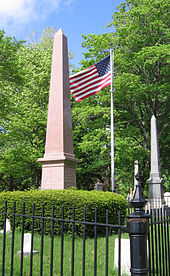 A pink obelisk marks Fillmore's grave at Buffalo's Forest Lawn Cemetery.
A pink obelisk marks Fillmore's grave at Buffalo's Forest Lawn Cemetery.
At the height of this crisis, the Royal Navy had fired on an American ship while at the same time 160 Americans were being held captive in Spain. Fillmore and his State Department were able to resolve these crises without the United States going to war or losing face.[26]
Because the Whig party was so deeply divided, and the two leading national figures in the Whig party (Fillmore and his own Secretary of State, Daniel Webster) refused to combine to secure the nomination, Winfield Scott received it. Because both the north and the south refused to unite behind Scott, he won only 4 of 31 states, and lost the election to Franklin Pierce.
After Fillmore's defeat the Whig party continued its downward spiral with further party division coming at the hands of the Kansas-Nebraska Act, and the emergence of the Know Nothing party.
In the history of the US presidency, Fillmore inaugurates a new era. All previous presidents had acquired substantial personal fortunes either through inheritance or marriage (or, in Martin van Buren's case, through work as an attorney). Fillmore was the first of a long line of late nineteenth century chief executives, mostly lawyers, who acquired only modest wealth during their lives, were "distinctly middle class" and who spent most of their careers in public service.[27]
The myth that Fillmore installed the White House's first bathtub was started by H. L. Mencken in a joke column published on December 28, 1917, in the New York Evening Mail. (See Bathtub hoax.) In February 2008, a television commercial for a sales event by Kia Motors featured Millard Fillmore, referring to him as "Unheard of," repeated the Bathtub hoax, and presented a Millard Fillmore bust as a 'Soap-on-a-Rope'.[28][29][30][31]
While Fillmore's letters and papers are owned by multiple institutions, including the Penfield Library of the State University of New York at Oswego, the largest surviving collection is in the Research Library at the Buffalo and Erie County Historical Society.[32]
See also
- President of the United States
- List of Presidents of the United States
- U.S. Presidents on U.S. postage stamps
Places named after Fillmore
- Fillmore, New York.
- Fillmore Glen State Park, New York.
- Fillmore County, Minnesota.
- Millard Fillmore Elementary School, Moravia NY.
- Fillmore County, Nebraska.
- Millard County, Utah and its county seat, Fillmore, Utah.
- Fillmore Elementary School, Davenport, IA
- Millard Fillmore Gates Circle Hospital, Buffalo.
- Millard Fillmore Suburban Hospital, Williamsville, New York.
- Millard Fillmore Academic Center at the University at Buffalo's Ellicott Complex.
- Fillmore's Tavern, a landmark restaurant in the Fresh Meadows neighborhood of New York City.
- Fillmore Street in Pasadena, LA, California
- Fillmore Street, and the surrounding neighborhood in San Francisco, California,[33] after which, in turn, the Fillmore Auditoriums were named, both East and West.
- Fillmore Avenue in Buffalo, New York[34]
- Fillmore Avenue in Las Vegas, Nevada
- Fillmore Avenue in East Aurora, New York
- Fillmore Avenue in Brooklyn, New York
- Fillmore Street in Vandalia, Illinois
Electoral history
United States presidential election, 1848
- Zachary Taylor/Millard Fillmore (Whig) – 1,361,393 (47.3%) and 163 electoral votes (16 states carried)
- Lewis Cass/William Orlando Butler (Democrats) – 1,223,460 (42.5%) and 127 electoral votes (15 states carried)
- Martin Van Buren/Charles Francis Adams, Sr. (Free Soil) – 291,501 (10.1%) and 0 electoral votes
United States presidential election, 1856
- James Buchanan/John C. Breckinridge (Democrats) – 1,836,072 (45.3%) and 174 electoral votes (19 states carried)
- John C. Fremont/William L. Dayton (Republicans) – 1,342,345 (33.1%) and 114 electoral votes (11 states carried)
- Millard Fillmore/Andrew Jackson Donelson (Know Nothing/Whig) – 873,053 (21.6%) and 8 electoral votes (1 state carried)
Plaques to Fillmore
-
The house is designated a National Historic Landmark.
-
The DAR placed this plaque on the house in 1931.
-
Historical marker denoting Fillmore's birthplace in Summerhill, New York
Ancestors
Ancestors of Millard Fillmore 16. John Fillmore 8. John Fillmore 17. Abigail Tilton 4. Nathaniel Fillmore 18. Nathaniel Day 9. Dorcas Day 19. Ruth Rowe 2. Nathaniel Fillmore 20. Ebenezer Wood 10. Ebenezer Wood 21. Mary Rudd 5. Hepzibah Wood 22. Stephen Story 11. Philippa Story 23. Mary Emerson 1. Millard Fillmore 24. Nehemiah Millard 12. Robert Millard 25. Phoebe Shore 6. Abiathar Millard 26. Eleazer Eddy 13. Hannah Eddy 27. Elizabeth Randall 3. Phoebe Millard 28. Ebenezer Hopkins 14. Ebenezer Hopkins 29. Mary Butler 7. Tabitha Hopkins 30. Daniel Messenger 15. Susannah Messenger 31. Lydia Royce Notes
- ^ The original log cabin was demolished in 1852, but in 1965, the Millard Fillmore Memorial Association, using materials from a similar cabin, constructed a replica, which is located in Fillmore Glen State Park in Moravia. "Millard Fillmore Log Cabin" American Presidents Life Portraits
- ^ "Millard Fillmore". Millard Fillmore. http://encarta.msn.com/encyclopedia_761569065/Millard_Fillmore.html.
- ^ Smyczynski, Christine A. (2005). "Southern Erie County – "The Southtowns"". Western New York: From Niagara Falls and Southern Ontario to the Western Edge of the Finger Lakes. The Countryman Press. p. 136. ISBN 0-88150-655-9.
- ^ Smith, H. Perry, ed. (1884). History of the City of Buffalo and Erie County: With illustrations and biographical sketches of some of its prominent men and pioneers, Volume I. D. Mason & Co. pp. 547–8. http://www.archive.org/details/historycitybuff00smitgoog.
- ^ Deacon, F. Jay (1999). "Transcendentalists, Abolitionism, and the Unitarian Association". UUA Collegium Lectures. Chicago. http://www.uua.org/ga/ga00/514.html. Retrieved December 28, 2006.
- ^ "A History of Livingston County, New York," by Lockwood R. Doty, 1876, pp. 673-676.
- ^ a b Facts on Millard Fillmore
- ^ Fillmore, Millard; Severance, Frank H. (1907). Millard Fillmore Papers. Buffalo Historical Society.
- ^ Paletta, Lu Ann; Worth, Fred L (1988). The World Almanac of Presidential Facts. World Almanac Books. ISBN 0345348885.
- ^
 Chisholm, Hugh, ed (1911). "Fillmore, Millard". Encyclopædia Britannica (11th ed.). Cambridge University Press.
Chisholm, Hugh, ed (1911). "Fillmore, Millard". Encyclopædia Britannica (11th ed.). Cambridge University Press. - ^
 "Fillmore, Millard". The American Cyclopædia. 1879.
"Fillmore, Millard". The American Cyclopædia. 1879. - ^ "A History of Jefferson County in the State of New York," by Franklin B. Hough, 1854, pg. 435.
- ^ a b c d e f Bahles, Gerald. "Millard Fillmore: Domestic Affairs." American President: Miller Center of Public Affairs. 2010. Retrieved September 7, 2010.
- ^ "The American Franchise". American President, An Online Reference Resource. Miller Center of Public Affairs, University of Virginia. http://millercenter.org/academic/americanpresident/fillmore/essays/biography/8. Retrieved March 13, 2008.
- ^ The book Presidents and Prophets: The Story of America's Presidents and the LDS Church (Covenant, 2007)
- ^ a b c d e f g h i j Bahles, Gerald. "Millard Fillmore: Foreign Affairs." American President: Miller Center of Public Affairs. 2010. Retrieved September 7, 2010.
- ^ Recess appointment; formally nominated on December 11, 1851, confirmed by the United States Senate on December 20, 1851, and received commission on December 20, 1851.
- ^ Hoffman was reassigned several times, beginning on January 18, 1854, as the California federal courts were redistricted. Hoffman, Ogden Jr., Federal Judicial Center.
- ^ "University of Buffalo bio". Ublib.buffalo.edu. http://ublib.buffalo.edu/archives/timeline/time1.html. Retrieved May 16, 2010.
- ^ Millard Fillmore bio from the Internet Public Library
- ^ Jeffrey M. Jones MD; Joni L. Jones PhD, RN. "Presidential Stroke: United States Presidents and Cerebrovascular Disease (Millard Fillmore)". Journal CMEs. CNS Spectrums (The International Journal of Neuropsychiatric Medicine). http://www.cnsspectrums.com/aspx/articledetail.aspx?articleid=605. Retrieved July 20, 2011.
- ^ Rayback 1959, pp. 286–292
- ^ Rayback 1959, pp. 420–422
- ^ Grayson 1981, p. 120
- ^ Grayson 1981, p. 83
- ^ Grayson 1981, pp. 103–109
- ^ "The Net Worth of the U.S. Presidents: From Washington to Obama". The Atlantic. May 2, 2010. http://www.theatlantic.com/business/archive/2010/05/the-net-worth-of-the-us-presidents-from-washington-to-obama/57020/. Retrieved February 14, 2011.
- ^ "Millard Fillmore’s Bathtub". Sniggle.net. December 28, 1917. http://sniggle.net/bathtub.php. Retrieved May 16, 2010.
- ^ Posted on Nov 6 2008 1:30 pm by Kelly Wilson (November 6, 2008). "H. L. Mencken: "A Neglected Anniversary"". Members.aol.com. http://members.aol.com/zoticus/bathlib/menck/ambath.htm. Retrieved May 16, 2010.
- ^ "White House Plumbing". Theplumber.com. December 28, 1917. http://theplumber.com/white.html. Retrieved May 16, 2010.
- ^ "Plumbing History in The White House". Plumbingworld.com. December 28, 1917. http://plumbingworld.com/historywhitehouse.html. Retrieved May 16, 2010.
- ^ "Guide to the Microfilm Edition of the Millard Fillmore Papers". http://www.bechs.org/library/FillmorePapers.pdf. Retrieved November 19, 2010.
- ^ Lewis, Gregory (February 8, 1997). "Fillmore Street name change urged". SFGate.com. http://www.sfgate.com/cgi-bin/article.cgi?f=/e/a/1997/02/08/NEWS10248.dtl&hw=jonestown&sn=164&sc=132. Retrieved February 25, 2008.
- ^ Vaughan, Bill (March 17, 1974) "Vaughan at Large: Prunes and Fillmore have something in common" Great Bend Tribune (Kansas) page 4
References
- Holt, Michael F. "Millard Fillmore". The American Presidency. Eds. Alan Brinkley, Davis Dyer, 2004. p. 145–151.
- Deusen, Van Glydon. "The American Presidency" Encyclopedia Americana. Accessed May 9, 2007.
- Overdyke, W. Darrell. The Know-Nothing Party in the South. Baton Rouge: Louisiana State University Press, 1950
- Rayback, Robert J. Millard Fillmore: Biography of a President. Buffalo, New York: Buffalo Historical Society, 1959
- Grayson, Benson Lee. The Unknown President: The Administration of Millard Fillmore. University Press of America, 1981
External links
- Millard Fillmore at the Biographical Directory of the United States Congress
- Millard Fillmore: A Resource Guide from the Library of Congress
- First State of the Union Address
- Second State of the Union Address
- Third State of the Union Address
- White House Biography
- Biography by Appleton's and Stanley L. Klos
- Works by Millard Fillmore at Project Gutenberg
- Millard Fillmore Internet Obituary
- Millard Fillmore House, Buffalo, NY
- Millard and Abigail Fillmore House, East Aurora, NY
- Millard Fillmore at Encyclopedia American: The American Presidency
- Essays on Fillmore and each member of his cabinet and First Lady
Articles and topics related to Millard Fillmore Presidents of the United States 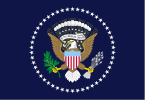
- George Washington
- John Adams
- Thomas Jefferson
- James Madison
- James Monroe
- John Quincy Adams
- Andrew Jackson
- Martin Van Buren
- William Henry Harrison
- John Tyler
- James K. Polk
- Zachary Taylor
- Millard Fillmore
- Franklin Pierce
- James Buchanan
- Abraham Lincoln
- Andrew Johnson
- Ulysses S. Grant
- Rutherford B. Hayes
- James A. Garfield
- Chester A. Arthur
- Grover Cleveland
- Benjamin Harrison
- Grover Cleveland
- William McKinley
- Theodore Roosevelt
- William Howard Taft
- Woodrow Wilson
- Warren G. Harding
- Calvin Coolidge
- Herbert Hoover
- Franklin D. Roosevelt
- Harry S. Truman
- Dwight D. Eisenhower
- John F. Kennedy
- Lyndon B. Johnson
- Richard Nixon
- Gerald Ford
- Jimmy Carter
- Ronald Reagan
- George H. W. Bush
- Bill Clinton
- George W. Bush
- Barack Obama
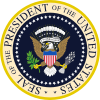
Vice Presidents of the United States 
- John Adams
- Thomas Jefferson
- Aaron Burr
- George Clinton
- Elbridge Gerry
- Daniel D. Tompkins
- John C. Calhoun
- Martin Van Buren
- Richard Mentor Johnson
- John Tyler
- George M. Dallas
- Millard Fillmore
- William R. King
- John C. Breckinridge
- Hannibal Hamlin
- Andrew Johnson
- Schuyler Colfax
- Henry Wilson
- William A. Wheeler
- Chester A. Arthur
- Thomas A. Hendricks
- Levi P. Morton
- Adlai Stevenson I
- Garret Hobart
- Theodore Roosevelt
- Charles W. Fairbanks
- James S. Sherman
- Thomas R. Marshall
- Calvin Coolidge
- Charles G. Dawes
- Charles Curtis
- John Nance Garner
- Henry A. Wallace
- Harry S. Truman
- Alben W. Barkley
- Richard Nixon
- Lyndon B. Johnson
- Hubert Humphrey
- Spiro Agnew
- Gerald Ford
- Nelson Rockefeller
- Walter Mondale
- George H. W. Bush
- Dan Quayle
- Al Gore
- Dick Cheney
- Joe Biden
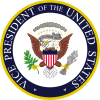
United States Whig Party Presidential Nominees William Henry Harrison / Daniel Webster / Hugh Lawson White / Willie Person Mangum · William Henry Harrison · Henry Clay · Zachary Taylor · Winfield Scott · Millard Fillmore · John BellUnited States Whig Party Vice Presidential Nominees Francis Granger / John Tyler · John Tyler · Theodore Frelinghuysen · Millard Fillmore · William Alexander Graham · Andrew Jackson Donelson · Edward EverettBuffalo, New York Attractions Entertainment Military and municipal Neighborhoods Allentown • Black Rock • Canal Street • Delaware District • East Lovejoy • East Side • North Buffalo • Riverside • South Buffalo • University Heights • Upper West SideResearch and education People Grover Cleveland • Carl Paladino • Millard Fillmore • Jack Kemp • O. J. Simpson • Gilbert Perreault • Bob McAdoo • Ralph Wilson • Warren Spahn • Jack Yellen • Jim Kelly • Thurman Thomas • Bruce Smith • Seymour Knox I • Seymour Knox II • Seymour Knox III • Timothy McVeigh • Goo Goo Dolls • Tim Russert • Wolf Blitzer • Nelson Baker • Rick James • Ani DiFrancoShopping Walden Galleria • Boulevard Mall • McKinley Mall • Eastern Hills Mall • Fashion Outlets of Niagara Falls • Rainbow Centre Factory Outlet (defunct) • The Summit (defunct) • Lockport Mall (defunct)Other Buffalo Museum of Science • Buffalo Philharmonic Orchestra • Anchor Bar • Lafayette Square • The French Connection • Delaware Park • Niagara Square • FBI Buffalo Field Office • Buffalo Turkey TrotNew York State Comptrollers Sands* • Curtenius** • Jones • Henry • Jenkins • McIntyre • Savage • Marcy • S Wright • Flagg • Cooke • Collier • Flagg • Fillmore • Hunt • Fuller • J Wright • Cook • Burrows • Church • Denniston • Robinson • Hillhouse • Allen • Nichols • Hopkins • Robinson • Olcott • Wadsworth • Davenport • Chapin • Wemple • Campbell • Roberts • Morgan • Gilman • Knight • Miller • Kelsey • Wilson • Glynn • Gaus • Kelsey*** • Williams • Sohmer • Travis • Wendell • Maier • Fleming • Murphy • Tremaine • Yates*** • O'Leary • Moore • McGovern • Levitt • Regan • McCall • Hevesi • Sanzillo*** • DiNapoli
* as Auditor General, ** as Auditor, *** ActingCabinet of President Zachary Taylor (1849–1850) Vice President Millard Fillmore (1849–1850)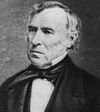
Secretary of State John M. Clayton (1849–1850)Secretary of the Treasury William M. Meredith (1849–1850)Secretary of War George W. Crawford (1849–1850)Attorney General Reverdy Johnson (1849–1850)Postmaster General Jacob Collamer (1849–1850)Secretary of the Navy William B. Preston (1849–1850)Secretary of the Interior Thomas Ewing (1849–1850)Cabinet of President Millard Fillmore (1850–1853) Vice President None (1850–1853)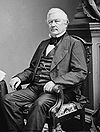
Secretary of State Daniel Webster (1850–1852) • Edward Everett (1852–1853)Secretary of the Treasury Thomas Corwin (1850–1853)Secretary of War Charles M. Conrad (1850–1853)Attorney General John J. Crittenden (1850–1853)Postmaster General Nathan K. Hall (1850–1852) • Samuel D. Hubbard (1852–1853)Secretary of the Navy William A. Graham (1850–1852) • John P. Kennedy (1852–1853)Secretary of the Interior Thomas M.T. McKennan (1850) • Alexander H.H. Stuart (1850–1853)Vice Presidents Succeeding Presidents John Adams · Thomas Jefferson · Martin Van Buren · John Tyler · Millard Fillmore · Andrew Johnson · Chester A. Arthur · Theodore Roosevelt · Calvin Coolidge · Harry S. Truman · Lyndon B. Johnson · Gerald R. Ford · George H. W. BushCategories:- 1800 births
- 1874 deaths
- American people of Scottish descent
- Deaths from stroke
- Fillmore family
- History of the United States (1849–1865)
- Members of the New York State Assembly
- Members of the United States House of Representatives from New York
- Millard Fillmore
- New York Anti-Masonics
- New York Know Nothings
- New York State Comptrollers
- New York Whigs
- People from Cayuga County, New York
- Presidents of the United States
- United States presidential candidates, 1856
- United States vice-presidential candidates, 1848
- University at Buffalo people
- Whig Party Presidents of the United States
- Whig Party Vice Presidents of the United States
Wikimedia Foundation. 2010.

